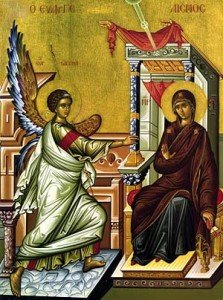As many know, our Church embraces an Eastern Christian tradition that is ancient. SS Cyril and Methodius came to the Slavic area, now known as Bulgaria, and brought with them the Christian traditions of the Byzantine Church, the Church as it found expression in Constantinople, present day Istanbul. Rusyns embraced this tradition. The center that supported the development of Christianity in the area now know as Ukraine was Kyiv. That is our tradition. There are, according to one author, two icons that are essential to understanding ourselves who worship in this Kyvian tradition and are members of the Ukrainian Greek-Catholic Church. Those two icons are the Annunciation, which relates the Incarnation of God as Jesus and Mary of the Sign or the Oranta.
 The Annunciation icon is traditionally placed on the Royal Doors of the iconastasis. It is the mystery which opens the Kingdom of God to us. The real significance of the encounter of Mary with the Archangel Gabriel is that she is asked to place her trust in God. It was truly a very thoughtful act. It was a challenge to her humanity which she met with maturity. Intelligent and personal commitment is what was expected of her and is also expected of each one of us. Our entire relationship to God has to come out of the precept that an intelligent being makes thoughtful decisions on all major aspects of human existence. Anything less than that does not befit our Creator and His Holy Wisdom. Western Christian tradition has a tendency to overplay the Mother of God’s virginity and in doing so distorts the essence of humanity in general and womanhood in particular. In Western Christianity, Mary is pictured alone. In Eastern Christianity she is never pictured without Christ.
The Annunciation icon is traditionally placed on the Royal Doors of the iconastasis. It is the mystery which opens the Kingdom of God to us. The real significance of the encounter of Mary with the Archangel Gabriel is that she is asked to place her trust in God. It was truly a very thoughtful act. It was a challenge to her humanity which she met with maturity. Intelligent and personal commitment is what was expected of her and is also expected of each one of us. Our entire relationship to God has to come out of the precept that an intelligent being makes thoughtful decisions on all major aspects of human existence. Anything less than that does not befit our Creator and His Holy Wisdom. Western Christian tradition has a tendency to overplay the Mother of God’s virginity and in doing so distorts the essence of humanity in general and womanhood in particular. In Western Christianity, Mary is pictured alone. In Eastern Christianity she is never pictured without Christ.
At a recent ecumenical Marian conference, Fr. Robert F. Taft, S.J., the theologian and major author on Eastern Christian worship, decried the Western reductionist approach to Mary. He thinks it is endemic to Mediterranean Catholic culture resulting in “machismo” only to be followed by more distortions and even abuse. Defining the Mother of God and her womanhood in the sexual context by glorifying female chastity ignores her intelligence. In the Western world her immaculate status seems to signify only abstention from sex, rather than expressing the sublime doctrine of the divine origin of the Only-begotten Son and Word of God, and the saving action of the Holy Spirit in Christ’s absolutely divine “Incarnation” to which the Mother of God agreed with great personal discernment.
The Eastern approach seems to highlight the fact that salvation is a cooperative act between God and man. It takes a person to commit themselves to the actualization of their potential to grow in their likeness of God as made manifest in the Person of Jesus.
